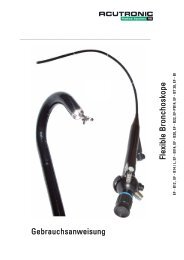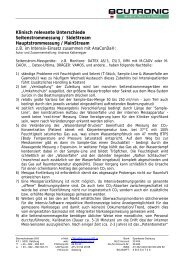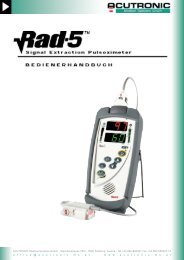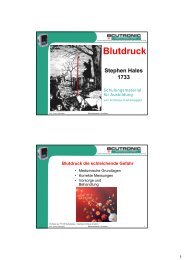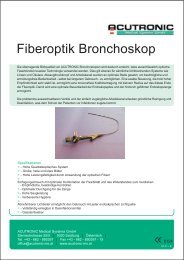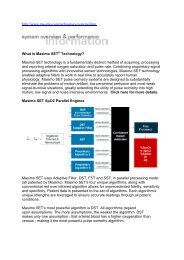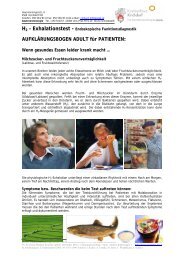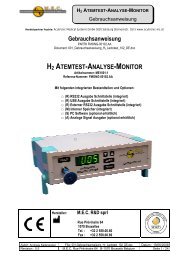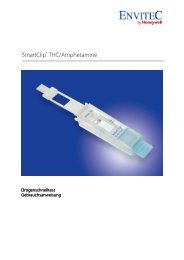Summary Carbon Monoxide Lurking within: The Danger of ...
Summary Carbon Monoxide Lurking within: The Danger of ...
Summary Carbon Monoxide Lurking within: The Danger of ...
You also want an ePaper? Increase the reach of your titles
YUMPU automatically turns print PDFs into web optimized ePapers that Google loves.
m a s i m o c o r p o r a t i o n 4 0 p a r k e r i r v i n e c a 9 2 6 1 8 w w w. m a s i m o . c o m<br />
Carboxyhemoglobinemia in Acute Care<br />
One study examines the cases <strong>of</strong> four pediatric heart transplant cases. 33 <strong>The</strong> patients showed a<br />
moderate increase in COHb level after nitroprusside administration, and in three <strong>of</strong> these cases<br />
the withdrawal <strong>of</strong> the drug led to the normalization <strong>of</strong> COHb level. If in fact prolonged treatment<br />
with moderate or high doses <strong>of</strong> sodium nitroprusside can produce carboxyhemoglobinemia in<br />
children after heart transplant, specific medical management after pediatric heart transplant<br />
should include frequent measurement <strong>of</strong> COHb. Even low levels <strong>of</strong> carbon monoxide bound to<br />
hemoglobin in cardiac compromised patients can be lethal, starving the tissues <strong>of</strong> oxygen due to<br />
functional anemia, poor perfusion, cardiac output compromise, and suboptimal oxygen delivery<br />
mechanisms.<br />
Accepted standards <strong>of</strong> patient monitoring associated with nitroprusside administration include<br />
analysis <strong>of</strong> MetHb concentrations. 34 Research suggests that COHb levels should be evaluated<br />
as well. Current blood analysis devices that measure CO-Oximetry in each blood gas sample<br />
permit diagnosis <strong>of</strong> moderate COHb elevations that probably would not have been discovered<br />
in the past. With noninvasive and continuous Pulse CO-Oximetry, results are faster and less<br />
resource-intensive than ever before. Of significant importance is the ability to trend the changes<br />
in COHb over time (see Figure 1), and view the trend at will. Days <strong>of</strong> trend data are saved for<br />
retrospective analysis <strong>of</strong> subtle changes in COHb (and when necessary, MetHb). Without the<br />
continuous assessment, the task <strong>of</strong> associating subtle changes in the dyshemoglobins is daunting,<br />
and impossible using traditional laboratory CO-Oximetry. As well, the trend value allows the<br />
patient to serve as their own baseline. At the beginning <strong>of</strong> the trend period, carboxyhemoglobin by<br />
Pusle CO-Oximetry (SpCO) may measure 1.0 percent, but with a course <strong>of</strong> sodium nitroprusside<br />
treatment, or following the transitions into SIRS, the clinician may note trends in elevation <strong>of</strong><br />
COHb, and interact accordingly with the patient to achieve the desired outcome.<br />
IV. COHb as a Marker<br />
Endogenous production <strong>of</strong> CO was first reported in the mid 20th century, but it has been a<br />
known poison since Claude Bernard first noted its high affinity for hemoglobin a century earlier. 35<br />
Moderate endogenous increases in COHb levels (0.8–2 percent) have been reported in critically<br />
ill patients 36 and clinical interest has grown rapidly as CO production has been proposed to induce<br />
excessive vascular relaxation, and hence a fall in blood pressure. 37 <strong>The</strong> mechanism behind this<br />
reaction is heme oxygenase (HO), the initial enzyme in heme metabolism. 38 HO produces CO<br />
during breakdown <strong>of</strong> heme molecules primarily in the liver and spleen. It is well established that<br />
metabolism <strong>of</strong> heme via heme oxidase results in production <strong>of</strong> one molecule <strong>of</strong> CO for each<br />
molecule <strong>of</strong> heme destroyed. 37 Recent data suggest that CO is also produced in the lungs. A<br />
number <strong>of</strong> stress-associated agents induce the expression <strong>of</strong> heme oxygenase, including heavy<br />
metals, hyperthermia, hyperoxia, hypoxia, heat shock, endotoxin, hydrogen peroxide, cytokines,<br />
ultraviolet radiation and nitric oxide, producing CO. 39-42<br />
To investigate whether critical illness results in increased CO production researchers have<br />
measured the CO concentration in exhaled air in critically ill patients and in healthy controls. 43<br />
Sampling exhaled CO is only an approximation <strong>of</strong> COHb levels in the blood. In patients with<br />
pulmonary compromise, high dead space to tidal volume ratios, or ventilation to perfusion<br />
mismatch, exhaled CO will correlate poorly with CO bound to hemoglobin and induce tissue<br />
hypoxemia. In a study <strong>of</strong> 95 mechanically ventilated, critically ill patients, CO production was<br />
correlated with multiple organ dysfunction score. Patients suffering from cardiac disease and<br />
critically ill patients undergoing dialysis produced significantly higher amounts <strong>of</strong> CO compared to<br />
other critically ill controls. <strong>The</strong> findings suggest that endogenous CO production might reflect the<br />
severity <strong>of</strong> acute organ dysfunction and therefore may <strong>of</strong>fer clinicians an effective, non-invasive<br />
gauge <strong>of</strong> patient condition. Two examples <strong>of</strong> this correlation exist in patients with sepsis and<br />
pulmonary inflammation.



